ZeroW, innovations to reduced food waste and loss to zero
- Europeo
- Desperdicio alimentario

ZeroW is a €12 million EU project about system innovation for zero food waste, financed by the Green Deal call of the Horizon 2020 program.
This project will last from 2022 to 2025, and will be implemented in collaboration with 46 interested parties in 17 countries.
ZeroW will provide credible solutions to significantly reduce FLW, involving all actors in the food system within a framework of collaboration, in order to accelerate the fair transition to a social, economic, and environmentally sustainable food system for all.
The role of food systems to provide safe, nutritional, and affordable food for all citizens, including vulnerable groups, is integrated and taken into consideration in the ZeroW demonstrative innovative solutions.
Packaging solutions to prolong the useful life of packaged products and to facilitate inventory management.

EROSKI, among others, is participating in the development of an innovative packaging solution for blue fish made with compostable materials and with an integrated freshness tag to reduce food waste. In this Living Lab, a serious problem with food waste is meant to be solved by precisely determining the useful life of fresh fish in supermarkets.
In the 2020 report “The State of World Fisheries and Aquaculture: Sustainability in Action,” the FAO estimated that approximately 35% of caught fish and aquaculture is lost or wasted every year.
Moreover, a market study on the markings of dates and other information provided on the food labels and on the prevention of food waste that was carried out by the European Commission calculated that 10% of the 88 million tons of food waste generated annually in the EU is due in one way or another to the lack of understanding or misunderstanding of the date on the label.
By finding a more intelligent solution for determining the expiration of fish products and labeling them correctly, we can reduce unnecessary waste and lower the pressure being placed on the fauna in our oceans.
A compartmentalized tray for fresh fatty fish will be developed with the aim of eliminating the need for using a non-recyclable absorbent pad to hold in what is exuded by the fish.
Moreover, a color-coded freshness label will be integrated with a reading application in order to more precisely determine the useful life, as well as push back the current expiration date when the product is still safe for eating. The goal of this label is to transform its visual indication (color change) of the product’s remaining useful life in order to provide information to retailers about the status of the product, and to facilitate improved inventory management.Follow the project’s social media accounts: Twitter, LinkedIn, and Youtube



